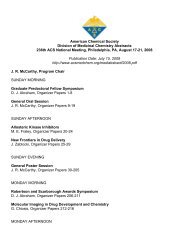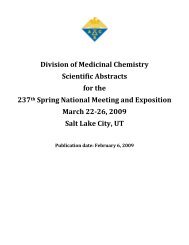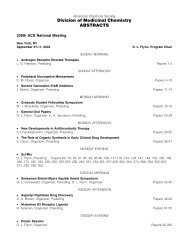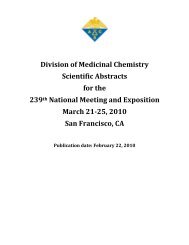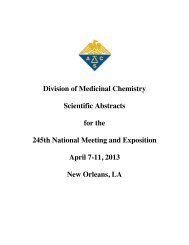Division of Medicinal Chemistry Abstracts-235th ACS National ...
Division of Medicinal Chemistry Abstracts-235th ACS National ...
Division of Medicinal Chemistry Abstracts-235th ACS National ...
- No tags were found...
Create successful ePaper yourself
Turn your PDF publications into a flip-book with our unique Google optimized e-Paper software.
DK226 is a conjugate <strong>of</strong> HA and methotrexate (MTX) designed to combine the advantages <strong>of</strong><br />
the two agents and overcome their shortcomings. Since MTX has a potent anti-inflammatory<br />
effect, the binding ratio <strong>of</strong> MTX needed for DK226 to exert sufficient efficacy is as low as 3%,<br />
and that makes it possible for the conjugate to preserve properties <strong>of</strong> HA, such as high<br />
molecular weight and visco-elasticity.<br />
In rat arthritic models, it was demonstrated that DK226 has anti-inflammatory effects and a<br />
superior analgesic effect to conventional HA. No systemic and local toxicity have been observed<br />
in preliminary toxicity studies. DK226, therefore, could provide a safe and effective new therapy<br />
for the treatment <strong>of</strong> OA.<br />
MEDI 69<br />
Investigation <strong>of</strong> ketone warheads as alternatives to the nitrile for preparation <strong>of</strong> potent<br />
and selective cathepsin k inhibitors<br />
Michael J. Boyd, Sheldon N. Crane, Joel Robichaud, John Scheigetz, Cameron Black, Nathalie<br />
Chauret, Qingping Wang, Frédéric Massé, and Renata Oballa, <strong>Medicinal</strong> <strong>Chemistry</strong>, Merck<br />
Frosst, 16711 Trans Canada, Kirkland, QC H9H 3L1, Canada, Fax: 514-428-4900,<br />
michael_boyd@merck.com<br />
Osteoporosis is a condition where bone becomes thin, weak and brittle. Consequently,<br />
osteoporosis can significantly increase the risk <strong>of</strong> bone fractures. The condition is caused by an<br />
imbalance between bone formation and bone resorption and it is believed that the lysosomal<br />
cysteine protease cathepsin K (Cat K) plays a key role in the degradation <strong>of</strong> the bone matrix.<br />
More specifically, Cat K is involved in the degradation <strong>of</strong> type I collagen which is the major<br />
component <strong>of</strong> the organic bone matrix. It has been hypothesized that Cat K inhibitors could<br />
therefore be used in the treatment <strong>of</strong> osteoporosis, and there has been considerable effort<br />
directed towards the development <strong>of</strong> potent and selective Cat K inhibitors over the last decade.<br />
Most reported inhibitors <strong>of</strong> Cat K contain electrophilic “warheads” which covalently bind to the<br />
catalytic Cys 25 residue, such as nitriles and ketones. Recently, we have reported the<br />
development <strong>of</strong> odanacatib (MK-0822), a reversible, non-basic, potent and selective nitrile<br />
inhibitor <strong>of</strong> Cat K. Amino ketone warheads were explored as alternatives to the nitrile group <strong>of</strong><br />
odanacatib. The ketones explored are potent and selective inhibitors <strong>of</strong> cathepsin K; however,<br />
they are generally less potent and selective than odanacatib. The SAR <strong>of</strong> the series <strong>of</strong> ketones<br />
will be discussed, as well as the effects <strong>of</strong> the nitrile replacement on metabolism and<br />
pharmacokinetics.



